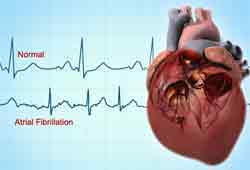Public Awareness of Atrial Fibrillation Is Low
In a Research and Practice in Thrombosis and Haemostasis study that surveyed the general public in 10 countries, only 48% of people were aware of atrial fibrillation (AF), which is lower than the awareness of other common diseases. AF is an irregular, often rapid heart rate that commonly causes poor blood flow. The rapid heartbeat may also allow blood to pool in the heart, which can cause clots to form and travel to the brain (potentially causing a stroke) or other parts of the body.
 Awareness about AF ranged from 25% to 69% across countries, while awareness of the risk factors for AF ranged from 8% to 52% and awareness that AF leads to stroke ranged from 36% to 46%. There is evidence that people were honestly assessing their awareness of AF because, of those who indicated they were aware of AF, 82% correctly identified palpitations as an important AF symptom.
Awareness about AF ranged from 25% to 69% across countries, while awareness of the risk factors for AF ranged from 8% to 52% and awareness that AF leads to stroke ranged from 36% to 46%. There is evidence that people were honestly assessing their awareness of AF because, of those who indicated they were aware of AF, 82% correctly identified palpitations as an important AF symptom.
There are an estimated 33.5 million people with AF around the world, with about 5 million new cases found every year. The rate of stroke or embolism in people with AF varies widely depending on the presence of other risk factors. Therefore, it is important to identify AF and provide appropriate preventive treatment against stroke for those at especially high risk.
“Recognizing atrial fibrillation is as easy as having a doctor feel your pulse. It doesn’t require an expensive diagnostic test,” said lead author Dr. Aaron Wendelboe, of the University of Oklahoma Health Sciences Center. “And since early recognition and treatment can be an easy way to prevent a stroke, then increasing the public’s awareness of atrial fibrillation should be a public health priority.”
Source: Wiley
Full bibliographic information:
Global public awareness about atrial fibrillation. Research and Practice in Thrombosis and Haemostasis.




